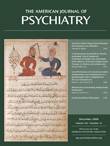Abstract
Objective: The serotonin transporter gene (SLC6A4) is a strong autism candidate gene because of its association with anxiety, aggression and attention, and the effectiveness of selective serotonin reuptake inhibitors (SSRIs) in treating certain behavioral symptoms. In families with individuals with autism, several reports of biased transmission of both alleles (short, long) at the serotonin transporter gene promotor polymorphism (5-HTTLPR) locus of SLC6A4 now exist. The heterogeneity in these reports may be due to clinical heterogeneity. The authors hypothesized that 5-HTTLPR genotypes would be related to variation in specific symptoms in children with autism. Method: The authors explored whether variants of two functional polymorphisms of SLC6A4 (5-HTTLPR, intron 2 variable number tandem repeat [2 VNTR]) were related to behavioral characteristics measured by the Autism Diagnostic Interview-Revised and Autism Diagnostic Observation Schedule. Subjects (N=73, age 3–19 years old) met diagnostic criteria for autistic disorder based on both measures. Results: Evidence of genotype-phenotype interactions on the Autism Diagnostic Interview-Revised was found with the 5-HTTLPR short group of HTTLPR (S/L or S/S genotypes) being rated as more severe on the subdomain “failure to use nonverbal communication to regulate social interaction,” and the long group (L/L genotype) being more severe on the subdomain “stereotyped and repetitive motor mannerisms” and on an aggression measure. In contrast, on the Autism Diagnostic Observation Schedule, the long group was associated with greater severity on directed facial expressions and unusual sensory interests. There were no significant relationships between the intron 2 VNTR genotypes and subdomains or domains of symptoms on the Autism Diagnostic Interview-Revised or the Autism Diagnostic Observation Schedule. Conclusions: These findings provide initial support for genotype-specific phenotypes for 5-HTTLPR in autism based on ratings from the Autism Diagnostic Interview-Revised and Autism Diagnostic Observation Schedule.



